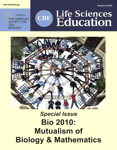Editorial
Introduction to Special Issue
Free
October 2017Beyond BIO2010: Integrating Biology and Mathematics: Collaborations, Challenges, and Opportunities
- Pages:141–142
Features
From the National Academies
Free
October 2017“Beyond BIO2010: Celebration and Opportunities” at the Intersection of Mathematics and Biology
- Pages:143–147
Current Insights
WWW.Life Sciences Education
Book Review
Educator Highlight
Approaches to Biology Teaching and Learning
Free
October 2017Order Matters: Using the 5E Model to Align Teaching with How People Learn
- Pages:159–164
Essays
Free
October 2017Toward Integration: From Quantitative Biology to Mathbio-Biomath?
- Pat Marsteller,
- Lisette de Pillis,
- Ann Findley,
- Karl Joplin,
- John Pelesko,
- Karen Nelson,
- Katerina Thompson,
- David Usher, and
- Joseph Watkins
- John Jungck, Monitoring Editor
- Pages:165–171
Free
October 2017Bioinformatics and the Undergraduate Curriculum
- John Jungck, Monitoring Editor
- Pages:172–174
Free
October 2017A Transformative Model for Undergraduate Quantitative Biology Education
- David C. Usher,
- Tobin A. Driscoll,,
- Prasad Dhurjati,
- John A. Pelesko,
- Louis F. Rossi,
- Gilberto Schleiniger,
- Kathleen Pusecker, and
- Harold B. White
- John Jungck, Monitoring Editor
- Pages:181–188
Free
October 2017Mathematics, Thermodynamics, and Modeling to Address Ten Common Misconceptions about Protein Structure, Folding, and Stability
- John Jungck, Monitoring Editor
- Pages:189–195
Free
October 2017Connecting Biology and Mathematics: First Prepare the Teachers
- John Jungck, Monitoring Editor
- Pages:196–200
Free
October 2017Mathematical Manipulative Models: In Defense of “Beanbag Biology”
- Pat Marsteller, Monitoring Editor
- Pages:201–211
Free
October 2017Impact of Interdisciplinary Undergraduate Research in Mathematics and Biology on the Development of a New Course Integrating Five STEM Disciplines
- John Jungck, Monitoring Editor
- Pages:212–216
Free
October 2017Enhancing Interdisciplinary Mathematics and Biology Education: A Microarray Data Analysis Course Bridging These Disciplines
- Pages:217–226
Articles
Free
October 2017Mathematical Biology Modules Based on Modern Molecular Biology and Modern Discrete Mathematics
- John Jungck, Monitoring Editor
- Pages:227–240
Free
October 2017An Initiative to Broaden Diversity in Undergraduate Biomathematics Training
- John Jungck, Monitoring Editor
- Pages:241–247
Free
October 2017From Biology to Mathematical Models and Back: Teaching Modeling to Biology Students, and Biology to Math and Engineering Students
- John Jungck, Monitoring Editor
- Pages:248–265
Free
October 2017Evaluating a Modeling Curriculum by Using Heuristics for Productive Disciplinary Engagement
- John Jungck, Monitoring Editor
- Pages:266–276
Free
October 2017Online Interactive Teaching Modules Enhance Quantitative Proficiency of Introductory Biology Students
- John Jungck, Monitoring Editor
- Pages:277–283
Free
October 2017Interdisciplinary Training in Mathematical Biology through Team-based Undergraduate Research and Courses
- John Jungck, Monitoring Editor
- Pages:284–289
Free
October 2017Using the Principles of BIO2010 to Develop an Introductory, Interdisciplinary Course for Biology Students
- John Jungck, Monitoring Editor
- Pages:290–297
Free
October 2017On a Calculus-based Statistics Course for Life Science Students
- John Jungck, Monitoring Editor
- Pages:298–310
Free
October 2017Preparing the “New” Biologist of the Future: Student Research at the Interface of Mathematics and Biology
- John Jungck, Monitoring Editor
- Pages:311–315
Free
October 2017Team Research at the Biology–Mathematics Interface: Project Management Perspectives
- John Jungck, Monitoring Editor
- Pages:316–322
Free
October 20171, 2, 3, 4: Infusing Quantitative Literacy into Introductory Biology
- Elena Bray Speth,
- Jennifer L. Momsen,
- Gregory A. Moyerbrailean,
- Diane Ebert-May,
- Tammy M. Long,
- Sara Wyse, and
- Debra Linton
- John Jungck, Monitoring Editor
- Pages:323–332
Free
October 2017How to Build a Course in Mathematical–Biological Modeling: Content and Processes for Knowledge and Skill
- John Jungck, Monitoring Editor
- Pages:333–341
Free
October 2017SYMBIOSIS: Development, Implementation, and Assessment of a Model Curriculum across Biology and Mathematics at the Introductory Level
- John Jungck, Monitoring Editor
- Pages:342–347
Free
October 2017RNA Secondary Structure Prediction by Using Discrete Mathematics: An Interdisciplinary Research Experience for Undergraduate Students
- John Jungck, Monitoring Editor
- Pages:348–356
Free
October 2017Computer Literacy for Life Sciences: Helping the Digital-Era Biology Undergraduates Face Today's Research
- John Jungck, Monitoring Editor
- Pages:357–363
Free
October 2017Developing Student Collaborations across Disciplines, Distances, and Institutions
- John Jungck, Monitoring Editor
- Pages:364–369
Free
October 2017Introductory Life Science Mathematics and Quantitative Neuroscience Courses
- John Jungck, Monitoring Editor
- Pages:370–377


